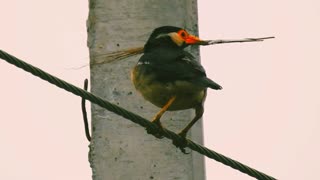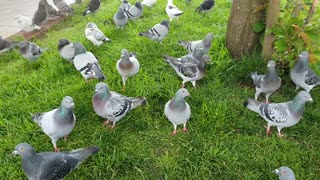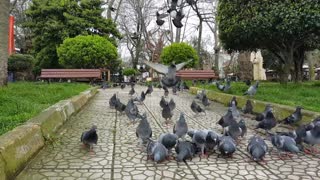A group of pigeons [nature and beautiful birds]
A group of pigeons
satisfying to watch
#pigeons #wildlife #beautiful #satisfying #birds #birdwatching #Columbidae
The domestic pigeon (Columba livia domestica or Columba livia forma domestica[2]) is a pigeon subspecies that was derived from the rock dove (also called the rock pigeon). The rock pigeon is the world's oldest domesticated bird. Mesopotamian cuneiform tablets mention the domestication of pigeons more than 5,000 years ago, as do Egyptian hieroglyphics.[3] Research suggests that domestication of pigeons occurred as early as 10,000 years ago.[3]
Pigeons have made contributions of considerable importance to humanity, especially in times of war.[4] In war the homing ability of pigeons has been put to use by making them messengers. So-called war pigeons have carried many vital messages and some have been decorated for their services. Medals such as the Croix de Guerre, awarded to Cher Ami, and the Dickin Medal awarded to the pigeons G.I. Joe and Paddy, amongst 32 others, have been awarded to pigeons for their services in saving human lives.
Despite this, city pigeons today are seen as pests, mainly due to their droppings. Feral pigeons are considered invasive in many parts of the world, though they have a positive impact on wild bird populations, serving as an important prey species of birds of prey.
Pigeons have served key roles in human society, such as food, pets, holy animals, messengers and in other roles for thousands of years. The earliest recorded mention of pigeons comes from Mesopotamia some 5,000 years ago. Pigeon Valley in Cappadocia has rock formations that were carved into dovecotes, perhaps an example of the earliest man-made structures to house pigeons.
Despite the long history of pigeons, little is known about the specifics of their initial domestication. Which subspecies of C. livia was the progenitor of domestics, exactly when, how many times, where and how they were domesticated, and how they spread, remains unknown. Their fragile bones and similarity to wild birds make the fossil record a poor tool for their study. Thus most of what is known comes from written accounts, which almost certainly do not cover the first stages of domestication.[6] There is strong evidence that some divergences in appearance between the wild-type rock dove and domestic pigeons, such as checkered wing patterns and red/brown coloration, may be due to introgression by cross-breeding with the speckled pigeon.[7][8][9][10]
Ancient Egyptians kept vast quantities of them, and would sacrifice tens of thousands at a time for ritual purposes. Akbar the Great traveled with a coterie of thousands of pigeons.[citation needed]
As the New World was colonized, the domestic pigeon was brought there as an easy source of food and as swift messengers. Around the 18th century, European interest in fancy pigeons began, and breeders there greatly expanded the variety of pigeons, importing birds from the Middle East and South Asia and mixing different breeds to create new ones.[6]
From a genetic perspective, there are two loose ancestral clades of pigeons, but there is striking genetic homogeneity due to frequent interbreeding and human directed cross-breeding. The first ancestral clade contains pigeons with exaggerated crops, tails, and manes; the second contains tumblers (the most diverse group), homing pigeons, owl pigeons, and those with exaggerated wattles.[6]
Because domestic and feral pigeons have extensively interbred with wild rock doves, wild-type pigeons may not truly exist anymore, or are nearly extinct. This frequent breeding further muddies the true origins of pigeons
-
 6:03
6:03
Live Nature
1 year agoAmong birds and birds in nature
15 -
 7:54
7:54
Live Nature
1 year agoBirds and other birds in nature
16 -
 0:31
0:31
vavkirill
4 years agoA flock of beautiful pigeons looking for food.
54 -
 0:26
0:26
Welcome
3 years agoA flock of friendly pigeons is outside in winter weather.
38 -
 0:27
0:27
Shorts video
3 years agopigeon peace bird
14 -
![Several pigeons eating on grass small foods, next to bushes and a building [Nature & Animals]](https://hugh.cdn.rumble.cloud/s/s8/6/l/q/5/x/lq5xc.0kob.1.jpg) 0:13
0:13
Nature & Animals
2 years agoSeveral pigeons eating on grass small foods, next to bushes and a building [Nature & Animals]
2 -
 0:15
0:15
JASONFERRY
5 years agoGroup Of Pigeons Waiting Owner To Open Their Houses On a Rooftop Birdcage
321 -
 0:27
0:27
greatpaulin24
3 years agoPigeons gather under the tree
521 -
 0:15
0:15
Imy369
3 years agoWonderful set of pigeons
361 -
 0:21
0:21
JASONFERRY
5 years agoCouples Pigeons Fly Over Some Unique Roofs
1